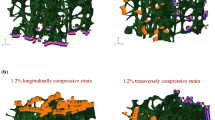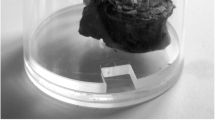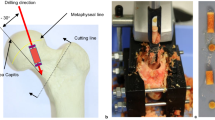Abstract
The purpose of this investigation was to determine the relation between compressive strength and density of human vertebral bone, the relation between trabecular orientation and compressive strength, and the effects of the strain rate on compressive strength. A total of 71 samples obtained at 23 post mortem examinations were investigated. Density determinations were made and two different densities were calculated: (1) the apparent density as wet weight divided by the total sample volume; and (2) real density as wet weight divided by the volume of bone matrix determined by water displacement.
Compression test measurements were made on the fresh samples using an Instron materials testing machine at controlled deformation rates. The results indicated a highly significant relation between apparent density and compressive strength. Similar relations were found between dry weight per total sample volume and ash weight per total sample volume and compressive strength. As the apparent density increased, the compressive strength of the sample decreased. A negative regression between real density and compressive strength was found in one of the experimental series of this investigation where, as the density of the bone matrix increased the compressive strength of the sample decreased. This relation was not significant in the other two experimental series.
The strength of vertebral bone was significantly higher along the superior-inferior axis or vertical axis than along the two other directions.
Samples showed a significantly greater ability to withstand compression when the deformation rate was 1 cm per minute than they did when the rate was 0.01 cm per minute.
Résumé
L'objet de ce travail est de déterminer le rapport existant entre une force compressive et la densité osseuse des vertèbres humaines, ainsi que le rapport entre l'orientation des travées et la force de compression et enfin les effets du degré de charge sur la force compressive. Ce travail est effectué sur 71 échantillons prélevés au cours de 23 autopsies. Les densités sont déterminées et 2 types de densités sont calculées: 1. la densité apparente, en poids humide, divisée par le volume total de l'échantillon et 2. la densité réelle, en poids humide, divisée par le volume de la matrice osseuse, déterminé par le déplacement de l'eau.
Des mesures de tests de compression sont effectuées sur des échantillons frais en utilisant une machine à tester les matériaux, de type Instron, sous des charges de déformation déterminées. Les résultats indiquent un rapport hautement significatif entre la densité apparente et la force de compression. Des rapports similaires sont trouvés entre le poids sec par volume total d'échantillon et le poids de cendre par volume total d'échantillon et la force compressive. Larsque la densité apparente augmente, la force compressive de l'échantillon diminue. Une régression négative entre la densité réelle et la force compressive est observée dans l'une des séries expérimentales de ce travail, où lorsque la densité de la matrice osseuse augmente, la force de compression de l'échantillon décroit. Ce rapport n'est pas significatif dans les deux autres séries expérimentales.
La force de l'os vertébral est significativement plus élevée le long de l'axe supéro-inférieur ou axe vertical que le long des deux autres directions. Certains échantillons présentent une capacité significativement plus élevée de résistance à la compression, lorsque la charge de déformation est de 1 cm par minute, que lorsqu'elle est de 0,01 cm par minute.
Zusammenfassung
Das Ziel dieser Untersuchung war, den Zusammenhang zwischen dem Widerstand gegen Kompression und der Dichte menschlicher Wirbel, den Zusammenhang zwischen der Anordnung der Trabekel und dem Kompressionswiderstand sowie die Auswirkung von der Belastung auf den Kompressionswiderstand festzustellen. Insgesamt wurden bei 23 Autopsien 71 Proben entnommen und untersucht. Es wurden Dichtebestimmungen vorgenommen und zwei verschiedene Dichten errechnet: 1. die scheinbare Dichte, bestimmt aus dem Naßgewicht dividiert durch das Gesamtprobenvolumen; 2. die effektive Dichte, bestimmt aus dem Naßgewicht dividiert durch das Volumen der Knochenmatrix, welches mittels Wasserverdrängung festgestellt werden konnte.
An frischen Proben wurden Test-Druckmessungen bei verschiedenen bekannten Deformationsgraden mittels eines Instron-Materialprüfgerätes durchgeführt. Die Resultate ergaben eine hochsignifikante Beziehung zwischen der scheinbaren Dichte und dem Widerstand gegen Kompression. Gleiche Beziehungen fanden sich zwischen dem Kompressionswiderstand einerseits und dem Trockengewicht sowie Aschegewicht andererseits, beide auf das Gesamtprobenvolumen bezogen. Bei Zunahme der scheinbaren Dichte nahm der Kompressionswiderstand der Probe ab. Eine negative Regression zwischen effektiver Dichte und Kompressions-widerstand wurde in einer der Versuchsreihen dieser Experimente gefunden, wo bei zunehmender Dichte der Knochenmatrix der Kompressionswiderstand der Proben abnahm. Diese Beziehung war in den andern beiden Versuchsreihen nicht signifikant.
Der Widerstand der Wirbelkörper war entlang der vertikalen Achse signifikant höher als in den andern beiden Richtungen.
Bei einem Deformationsgrad von 1 cm/min zeigten die Proben eine signifikant höhere Widerstandskraft als bei einem solchen von 0,01 cm/min.
Similar content being viewed by others
References
Arnold, J.: Quantitation of mineralization of bone as an organ and tissue in osteoporosis. Clin. Orthop.17, 167–175 (1960).
—, Tont, S.A.: Bone water studied by differential centrifugation. Calc. Tiss. Res.1, 68–74 (1967).
Bell, G.H., Dunbar, O., Beck, J.S.: Variations in strength of vertebrae with age and their relation to osteoporosis. Calc. Tiss. Res.1, 75–80 (1967).
Dempster, W.T., Liddicoat, R.T.: Compact bone as a nonisotropic material. Amer. J. Anat.91, 331 (1952)
Evans, F. G., King, A.: Regional differences in some physical properties of human spongy bone. In: Evans et al., Biomech. studies of the musculo-skeletal system, chap. 3, p. 49–67. Springfield 1961.
—, Lebow, M.: Regional differences in some of the physical properties of the human femur. J. appl. Physiol.3, 563 (1950–1951).
Galante, J.: Tensile properties of the human lumbar annulus fibrosus. Acta orthop. scand., Suppl., 100 (1967).
Göcke, C.: Das Verhalten spongiösen Knochens im Druck- und Schlagversuch. Verh. dtsch. orthop. Ges.20, 114 (1926).
—: Traumatische Wirbelumformung im Versuch. Hefte Unfallheilk. H.8, 136 (1931).
Hardinge, M.C.: Determination of the strength of cancellous bone in the head and neck of the femur. Surg. Gynec. Obstet.89, 439–441 (1949).
Harkness, R.D.: Biological functions of collagen. Biol. Rev.36, 399 (1961).
Hirsch, C., Da Silva, O.: The effect of orientation on some mechanical properties of femoral cortical specimens. Acta orthop. scand. (1967 in press).
Knese, K.H.: Knochenstruktur als Verbundbau: Zwanglose Abhandlungen auf dem Gebiet der normalen und pathologischen Anatomie. Stuttgart: Thieme 1958.
Lange, C.: Untersuchungen über Elastizitätsverhältnisse in den menschlichen Rückenwirbeln mit Bemerkungen über die Pathogenese der Deformitäten. Dtsch. orthop. Chir.10, 47 (1902).
McElhaney, J.H.: Strain rate sensitivity of certain biological materials. Diss. Univer. West Virginia, Morgantown (1965).
Messerer, O.: Über Elasticität und Festigkeit der menschlichen Knochen. Stuttgart: J. G. Cotta 1880.
Rauber, A.A.: Elasticität und Festigkeit der Knochen. Leipzig: W. Engelmann 1876.
Sedlin, E. D.: A rheological model for cortical bone. A study of the physical properties of human femoral samples. Acta orthop. scand. Suppl., 83 (1965).
—, Hirsch, C.: Factors affecting the determination of the physical properties of femoral cortical bone. Acta orthop. scand.37, 29 (1966).
Smith, J. W., Walmsley, R.: Factors affecting the elasticity of bone. J. Anat. (Lond.)93, 503 (1959).
Stucke, K.: Über das elastische Verhalten der Achillessehne im Belastungsversuch. Langenbecks Arch. klin. Chir.265, 579 (1950).
Urist, M.R.: Observations bearing on the problem of osteoporosis. In: Bone as a tissue (K. Rodahl, J.T. Nicholson, and E.M. Brown, eds.), p. 16–45. New York: McGraw-Hill Book Co., Inc. 1960.
Vose, G.P.: The relation of microscopic mineralization to intrinsic bone strength. Anat. Rec.144, 31–36 (1962).
—, Stover, B.J., Mack, P.B.: Quantitative bone strength measurements in senile osteoporosis. J. Geront.16, 120–124 (1961).
Weaver, J.K., Chalmers, J.: Cancellous bone: Its strength and changes with aging and an evaluation of some methods for measuring its mineral content. 1. Age changes in cancellous bone. J. Bone Jt Surg.48, 289 (1966).
Author information
Authors and Affiliations
Additional information
Supported by NIH grant AM 12567.
Rights and permissions
About this article
Cite this article
Galante, J., Rostoker, W. & Ray, R.D. Physical properties of trabecular bone. Calc. Tis Res. 5, 236–246 (1970). https://doi.org/10.1007/BF02017552
Received:
Accepted:
Issue Date:
DOI: https://doi.org/10.1007/BF02017552




